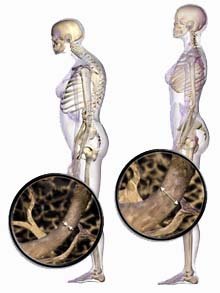Smoking and the use of nicotine negatively affect all systems and tissues in the human body. People know of the dangers such as heart disease, lung disease, stroke, and increased risk of cancer. What is less know is that smoking damages the vertebral column and spine, causing intervertebral disc disease and accelerating osteoporosis.
The intervertebral disc?
the intervertebral disc connects adjacent vertebral bones. These discs are shock absorbers between each vertebrae in the spine. The disc provides alignment and spinal stability while absorbing compressive forces and enabling movement between spinal bones.
Nicotine use and degenerative disc disease in your spine:
 The connection between smoking, your spine, and back pain in adults has been proven by decades of research.
The connection between smoking, your spine, and back pain in adults has been proven by decades of research.
Degenerative disc disease is a condition where the vertebral discs are compromised and weakened, Their function to act as a cushion between vertebrae has been significantly reduced. The discs become softer, less efficient, and more susceptible to injury. Degenerative discs can develop naturally as part of the aging process or as a result of injury. Degenerative discs usually commence with micro annular tears, which do heal but leave scar tissue, which is not as strong as the original disc wall. Over time, the process of tearing and scarring ultimately weakens the disc wall.
The inner portion of the disc known as the nucleus is fluid rich and it’s this hydrated structure that functions as a shock absorber. The nucleus can collapse causing the spinal bones to move closer together, resulting in improper alignment. This improper alignment can lead to arthritic changes, bone spur formation, herniated discs, and pinched nerves, all of which cause pain.
The use of nicotine may be directly responsible for disc degeneration, by causing damage to the nucleus and annuls. This impacts the long-term health and functional ability of the discs. All these harmful changes mean that smokers not only damage healthy discs but also accelerate the degeneration of pre-existing damaged discs.
Osteoporosis and smoking:
Osteoporosis arises from the Greek term “porous bone” It is a bone-thinning disease identified by losing too much bone and replacing enough new bone. This decrease in bone tissue leads to frail weak bones which are at risk of fracture.
Spinal fractures are the most common type of fractures as a result of osteoporosis.
Many studies have associated smoking with decreased bone health. Tobacco smoking has been proposed to inhibit the activity of osteoblasts. Smoking is an independent risk factor for osteoporosis. Smoking also has secondary effects upon advancing osteoporosis. It increases the breakdown of exogenous estrogen, lowers body weight, and causes earlier menopause, all of which contribute to lower bone mineral density.
Studies have found that females who smoked more than a pack per day throughout adulthood had on average 5-10% lower bone density than non-smokers in the low back by the time they reached menopause. Second-hand smoke has been shown to reduce bone mineral density. Smoking accelerates the loss of bone density in all bones, and the rate of loss is related to the daily number of cigarettes smoked and years of exposure.
This is an independent risk factor from other factors that contribute to bone health such as sex, age, weight, BMI, and unhealthy lifestyle habits. For smoking alone, the risk of a spinal fracture is increased by 32% in men and 13% in women. Smoking also delays fracture healing. This is caused by the toxic activity of nicotine which inhibits the growth of cells essential for healing and reduces blood and oxygen supply to the injured tissue.
Quitting smoking can be difficult. These five steps are the START of every successful plan to quit smoking.
• Set a quit date.
• Tell family, friends and co-workers you plan to quit.
• Anticipate and plan for the challenges you will face while quitting.
• Remove cigarettes and other tobacco products from your home, car, and workplace.
• Talk to your doctor about getting help to quit.
I am text block. Click edit button to change this text. Lorem ipsum dolor sit amet, consectetur adipiscing elit. Ut elit tellus, luctus nec ullamcorper mattis, pulvinar dapibus leo.
